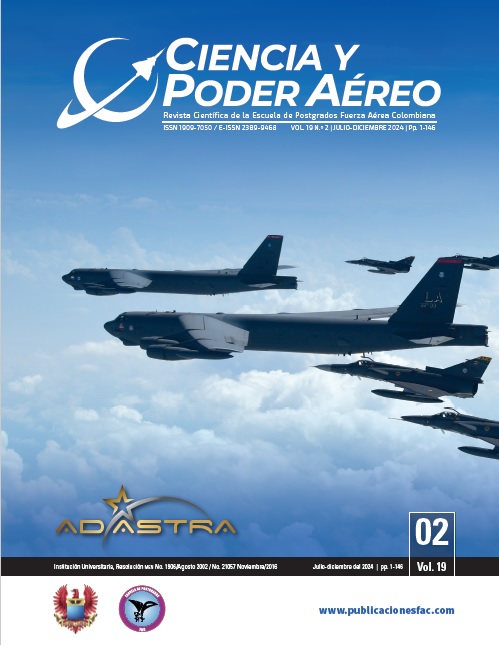Artificial intelligence for thecreation of 3D models appliedin a virtual reality environment
DOI:
https://doi.org/10.18667/cienciaypoderaereo.825Keywords:
Inteligencia artificialAbstract
The idea for this project was conceived and developed over six months, from January to June 2023, in a research group focused on virtual reality (VR), aiming to use artificial intelligence (AI) for creating 3D models and presenting them in a showroom. The goal was to find and prove that by using AI, 3D models can be presented in VR. This was carried out by following a series of steps. For creating the models, the AI Point-E was used, enhancing the models in Blender software and importing them into a showroom created using Unity software. Finally, a showroom with 3D models presented as a museum was obtained, which could be viewed and manipulated using an “HTC VIVE” kit. Based on the results obtained, it was concluded that the project’s objective was met, although these results are not definitive due to current technological limitations; however, it was proven that AI can generate 3D models and they can be used in VR.
Downloads
References
Al-Gindy, A., Felix, C., Ahmed, A., Matoug, A. y Alkhidir, M. (2020). Virtual Reality: Development of an Integrated Learning. IJIET: International Journal of Information and Education Technology, 10(30).171-175. https://doi.org/10.18178/ijiet.2020.10.3.1358
Barba-Robles, A. (2022). Modelado de una vivienda en Blender y UE4 (trabajo de grado, Universidad de Alicante). Repositorio institucional RUA. https://tinyurl.com/yu4h2xjc
Calderón, S. J., Tumino, M. C. y Bournissen, J. M. (2020). Realidad virtual: impacto en el aprendizaje percibido de estudiantes de Ciencias de la Salud. Revista Tecnología, Ciencia y Educación, (16), 65-82. https://tinyurl.com/332b5pzt
Dondé, E. (2019, diciembre 19). Curso Gratuito de Unity VR [en línea] https://tinyurl.com/4zss3nzr
Erazo-Luzuriaga, A. F., Ramos-Secaira, F. M., Galarza-Sánchez, P. C. y Boné-Andrade, M. F. (2023). La inteligencia artificial aplicada a la optimización de programas informáticos. jessr: Journal of Economic and Social Science Research, 3(1). https://doi.org/10.55813/gaea/jessr/v3/n1/61
Garrido-Monagas, M. y Méndez-León, A. (2022). 2PVirtualProc. Introducción a Blender (trabajo de grado, Universidad Tecnológica de La Habana José Antonio Echeverría) [en línea]. https://tinyurl.com/435wdprm
Google. (s. f.). Colaborarory [en línea]. https://tinyurl.com/nk49m3bt
Google Cloud. (2022). ¿Qué es la inteligencia artificial (IA)? [en línea]. https://tinyurl.com/44vcdezu
Hernández-Sampieri, R. y Mendoza-Torres, C. P. (2000). Metodología de la investigación: las rutas cuantitativa, cualitativa y mixta. McGraw-Hill.
Iberdrola. (s. f.). Realidad virtual: otro mundo al alcance de tus ojos [en línea]. https://tinyurl.com/58s7yrwr
Intelarter. (2023, mayo 4). ¿Qué es Point-E? Nueva herramienta de ia para crear modelos 3D [en línea]. https://tinyurl.com/2runw9tn
Liz-Gutiérrez, A. M. L. (2020). ¿Un mundo nuevo? Realidad virtual, realidad aumentada, inteligencia artificial, humanidad mejorada, Internet de las cosas. Arbor, 196(797). https://doi.org/10.3989/arbor.2020.797n3009
Nichol, A., Jun, H., Dhariwal, P., Mishkin, P. y Chen, M. (2022). Point·E: A System for Generating 3D Point Clouds from Complex Prompts. arXiv [en línea]. https://doi.org/10.48550/arXiv.2212.08751
Poole, B., Jain, A., Barron, J. T. y Mildenhall, B. (2022). DreamFusion: Text-to-3D using 2D Diffusion. arXiv [en línea]. https://dreamfusion3d.github.io/
Robayo-Ramírez, J. F., Simanca-Herrera, F. A., & Santa-Quintero, R. A. (2023). Visualización de datos captados por satélites en un showroom de realidad virtual (VR). Avenir, 7(1).
Saavedra, J. Á. (2023, agosto 7). ¿Qué es el modelado 3D y cómo funciona? Escuela Británica de Artes Creativas y Tecnología [en línea]. https://ebac.mx/blog/que-es-elmodelado-3d
Schwab, K. (2016). La Cuarta Revolución Industrial. Editorial Debate
Sharma, A., Khan, F., Sharma, D., & Gupta, S. (2020). Python: The Programming Language of Future. IJIRT: International Journal of Innovative Research in Technology, 6(2). 115-118. https://tinyurl.com/v363x93d
Tickoo, S. (2019). Autodesk Maya 2019: A Comprehensive Guide, 11th Edition (11.a ed.). CADCIM Technologies.
Downloads
Published
Issue
Section
License
Copyright (c) 2024 Escuela de Postgrados de la Fuerza Aérea Colombiana

This work is licensed under a Creative Commons Attribution 4.0 International License.
Assignment of Copyrights
Authors assign Ciencia y Poder Aéreo journal the exclusive rights (reproduction, distribution, public communication, and transformation) to exploit and commercialize their work, in whole or in part, in all the formats and modalities of present or future exploitation, in all languages, throughout the life of the work and throughout the world.
All contents published in Ciencia y Poder Aéreo journal are licensed under a Creative Commons Attribution 4.0 International License, whose complete information is available at http://creativecommons.org/licenses/by/4.0/
Under the terms of this license, users are free to download, print, extract, archive, distribute and publicly communicate the content of articles, provided that proper credit is granted to authors and Ciencia y Poder Aéreo, scientific journal of the Graduate School of the Colombian Air Force. Except when otherwise indicated, this site and its contents are licensed under a Creative Commons Attribution 4.0 International License.
For other uses not considered under this license it is required to contact the Director or the Editor of the journal at the e-mail address cienciaypoderaereo1@gmail.com.
The Graduate School of the Colombian Air Force and this publication are not responsible for the concepts expressed in the articles, including the metadata or the affiliation stated by authors. This is the full responsibility of the authors.






















